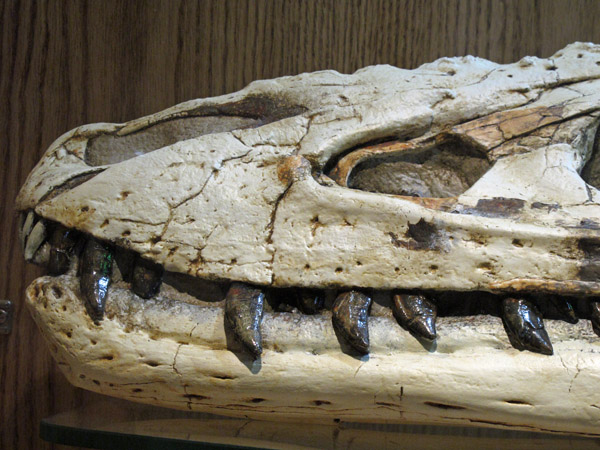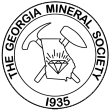"Dinosaur Paleobiology"
by
Cameron, age 16

Tyrannosaur, Alioramus sp. (al-ee-oh-ray-mus), Late Cretaceous (68 MYA), Mongolia
"This skull exhibits several features uniting it within the Tyrannosauridae, the same group as Tyrannosaurus rex."
The Wyoming Dinosaur Center & Dig Sites, Thermopolis, Wyoming
Dinosaurs were some of the most amazing animals to have ever lived. They capture the imagination of children and adults from around the world. Our knowledge of them changes every day. Back during the 1800s our depiction of dinosaurs was dead wrong. We thought that dinosaurs were stupid, tail-dragging, swamp-dwelling, and cold-blooded animals. Nothing was further from the truth. Dinosaurs were warm-blooded, colorful, and more active creatures than we thought. Dinosaurs dominated the globe for more than 160 million years. They roamed every corner of the planet. Paleontologists want to understand how to piece together their biology, anatomy, evolution, and behavior. This science is called Dinosaur Paleobiology.
During the Mesozoic era or “Age of Reptiles” the earth’s landmasses were bunched up into one single super continent called Pangea. Because of the driving of plate tectonics, dinosaurs were able to evolve into many species. Throughout the Mesozoic era, continents started to drift further and further apart. This would lead to isolation to many species of dinosaurs. Isolation would eventually lead to new species. The planet was broken up into two landmasses, Laurasia in the northern hemisphere and Gondwanaland in the southern hemisphere.
To really understand dinosaur paleobiology we have to look at what the fossil record wants us to know. Scientists can tell whether a specific dinosaur was a juvenile or an adult based upon information in the bone itself. The inside of a dinosaur bone is similar to the inside of a tree. Scientist are able to take a thin section of a dinosaur bone and count the rings in it. By doing this, scientists can tell what age the dinosaur stopped growing.
Dinosaurs would have had many sexual displays such as feathers, crest, horns, and a range of colors. Dinosaurs would probably have used these features in a similar way as a peacock would use its features today. Some of these features could also be used to identify male and female. Mating was also very dangerous at times. Broken bones and bite marks on the skull would have been a result of mating between the opposite sexes.
By using many scientific techniques, we can answer questions about dinosaurs that we haven’t been able to answer in hundreds of years. New dinosaur discoveries are being made every year. As more fossil material is being unearthed, we will learn more about these incredible animals. The relatives of these long lost creatures still fly above our heads today.
Bibliography:
http://www.museumoftherockies.org/AboutMOR/WhoWeAre/JackHorner.aspx
http://s17.photobucket.com/user/Seawolf9/media/coelophysis.jpg.html
http://www.amnh.org/var/ezflow_site/storage/images/amnh/import_exhibits/import_exhibit_images/2-5_trexrib.jpg/232052-1-eng-US/2-5_trexrib.jpg.jpg
http://accpaleo.files.wordpress.com/2013/04/tri-ontogeny-1.jpg
http://blog.everythingdinosaur.co.uk/wp-content/uploads/2008/01/Tenontosaurus.jpg
http://news.bbcimg.co.uk/media/images/76777000/jpg/_76777371_yangi.jpg
http://0.tqn.com/d/dinosaurs/1/S/M/Q/-/-/dilophosaurusSK.jpg
http://www.planbooktravel.com.au/businesses/qld/winton/attractions/lark-quarry-conservation-park/9007114_1.JPG
http://creationwiki.org/pool/images/thumb/8/8c/Dino_tracks.jpg/300px-Dino_tracks.jpg
http://www.bing.com/images/search?q=medullary+bone+in+a+tyrannosaurus+rex&FORM=HDRSC2&id=93D7AFEA4ECAF5AA589603C4340E00EA0BCDBA65&selectedIndex=0#view=detail&id=36E9FDB5670ED1D0EBAE7B333AE87DFA4EA12A36&selectedIndex=27
http://www.slate.com/blogs/wild_things/2014/07/15/largest_flying_dinosaur_four_wings_on_changyuraptor_kept_it_from_crash_landing.html
http://news.bbcimg.co.uk/media/images/77352000/jpg/_77352667_dreadnoughtus.jpg
http://news.sky.com/story/1330466/dreadnought-dinosaur-feared-nothing

Copyright © Georgia Mineral Society, Inc.
